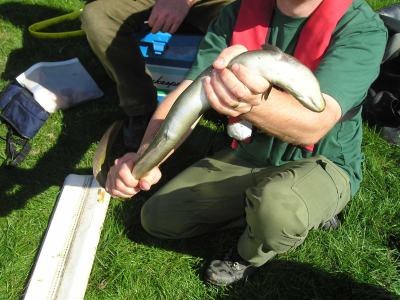The eel population in the East of England has reduced dramatically, with eel populations throughout Europe thought to be at only 5% of levels present in the 1980s. To try to stop the eel population slipping away completely, and with luck, to help increase numbers again, the Environment Agency is implementing an eel management plan.
Simple measures, such as putting structures in place to help eels get past weirs and other obstructions and installing special traps around the region to check how many glass eels are migrating upstream, are being taken by the Environment Agency. They hope these will help eel numbers to recover and highlight what more could be done to help eel numbers increase.
Most of the eels seen in the East of England are females, which are especially important for conservation of the species. There are fears that eels could become extinct, having a significant impact for other species and parts of our economy.
 Nigel Tomlinson, Fisheries Principal Officer from the Environment Agency said, “Eels have a fascinating and unique life-cycle, in which our rivers in the East of England play an important role. Without them, there would be a serious impact on river ecology. They are also an important source of food for species such as the bittern and otter. We are at a point where eels could become extinct, which is why we’re doing this work now to stop that happening.”
Nigel Tomlinson, Fisheries Principal Officer from the Environment Agency said, “Eels have a fascinating and unique life-cycle, in which our rivers in the East of England play an important role. Without them, there would be a serious impact on river ecology. They are also an important source of food for species such as the bittern and otter. We are at a point where eels could become extinct, which is why we’re doing this work now to stop that happening.”
All European eels start life in the only known spawning ground in an area of the Sargasso sea, south of Bermuda. The larvae follow the Gulf Stream and North Atlantic Drift to return to Europe metamorphosing into glass eels when they reach the continental shelf.
Glass eels are attracted to freshwater and enter UK rivers in Spring. Glass eels become pigmented and metamorphose into elvers, spending a number of years in rivers and lakes, feeding and growing. After an average of 6 years for males and 9 years for females, eels begin to mature, stop feeding and turn silver. Silver eels swim downstream towards the sea to begin the long migration of 5500 km back to the Sargasso Sea, where they will spawn and die.
Eels are still caught for the table in the East of England, the most well known location being Ely, Cambridgeshire. Fishermen must be licensed, but at present there is no limit on how many eels they may take. Fisheries laws are currently being reviewed to bring more protection for the eel.

Installing An Eel Pass








